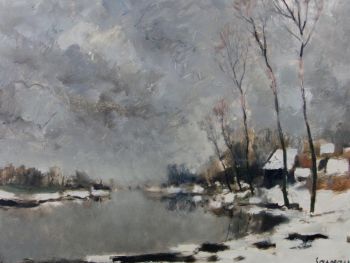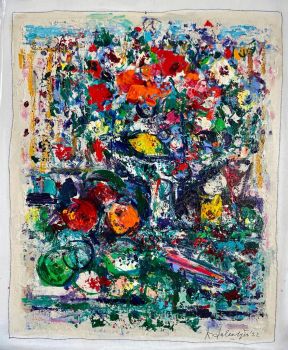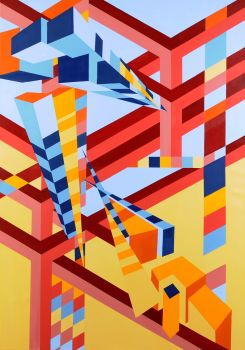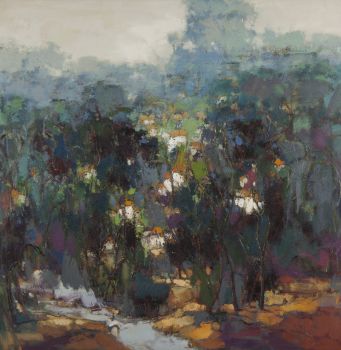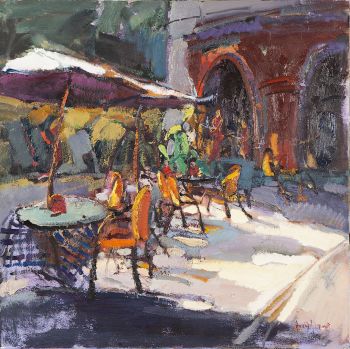Study of a Guarani man, Argentina, circa 1922 1922
José Moreno Carbonero
TelaPittura a olioDipingere
32 ⨯ 26 cm
Prezzo su richiesta
Zebregs & Röell - Fine Art - Antiques
- A proposito di opere d'arteJosé Moreno Carbonero (1858-1942)
Oil on canvas, H. 32.2 x W. 26 cm
Moreno Carbonero was born, brought up and studied in Malaga, Spain. In 1875, after a two-year stay in Morocco, he moved to Paris on a grant from the Malaga Provincial Council. He joined the studio of Jean-Léon Gérôme. A regular visitor, the famous art dealer Adolphe Goupil commissioned his first works, mainly small genre subject paintings. Between 1881 and 1884, Moreno Carbonero lived in Rome before moving to Madrid. There, he achieved his first success with his painting The Conversion of the Duke of Gandia, which is now in the Prado Museum. From then on, the artist specialized in history paintings, often on a large scale; the best example is The Entry of Roger de Flor into Constantinople, painted for the Madrid Senate in 1888, which hasn’t moved ever since. Besides being a historical painter, the artist was also a portraitist, painting elegant portraits of Madrid's high society (see, for instance, Purificacion Fontan, Marquise del Pazo de la Merced, 1908, Prado Museum, Madrid).
At the beginning of the 20th century, the Argentine government was preparing to celebrate the May Revolution, which started on May 18, 1810, and led to the independence of Argentina. The municipality of Buenos Aires, joining in the celebration, commissioned a historical painting dedicated to the founding of the capital from José Moreno Carbonero. Under time pressure, Moreno Carbonero produced a work with which he was dissatisfied and criticized when he arrived in Argentina in 1910. For this reason, in 1922, he asked for the work to be returned to him to correct it. He studied the city's history, the site and the event depicted in situ and made substantial changes to make the painting more historically accurate. The definitive work, wholly reworked, was placed in the municipal palace in 1924. It can still be admired in its original place.
The city of Buenos Aires was founded on June 11, 1580, by Juan de Garay under the name of the 'Santissima Trinidad y Puerto de Sant Maria del Buen Ayre'. In Moreno Carbonero's painting, Juan de Garay, in the centre of the composition, raises his sword before the foundation pillar. On the right, the notary Pedro de Xeres signs the foundation act; on the left, the friar Juan de Rivadeneira raises the cross, and the alderman Don Pedro de Quirós carries the royal standard. All around, men in arms can be seen, as well as representatives of the native people from the area, including a man from the Guarani ethnic group. The present painting is a preparatory sketch of the head of this figure. - A proposito di opere artista
Nato a Malaga il 24 marzo 1858, José Moreno Carbonero si formò inizialmente come artista presso la Scuola Superiore di Belle Arti della città, dove fu allievo di Bernardo Ferrándiz e dimostrò fin dalla tenera età uno straordinario talento per la pittura. Dopo aver viaggiato a Siviglia e Parigi con una borsa di studio concessa dalla Diputación di Malaga (consiglio provinciale), all'età di soli ventuno anni eseguì lì il suo primo grande dipinto storico, El príncipe de Viana (“Il principe di Viana”, 1881). , che lo consacrò come uno dei grandi maestri del genere, come confermato solo pochi anni dopo da opere significative come La conversión del duque de Gandía (“La conversione del duca di Gandía”, 1884) e la splendida Entrada de Roger de Flor en Constantinopla (“Entrata di Roger de Flor a Costantinopoli”, 1884), commissionato dal Senato ed è senza dubbio uno dei dipinti di storia spagnola più importanti del XIX secolo.
Nel 1898 Moreno divenne membro dell'Accademia San Fernando di Madrid e si stabilì definitivamente nella città. Da allora in poi visse comodamente nella sua villa in Calle Miguel Ángel e fu acclamato come uno dei ritrattisti più rinomati dell'alta società, anche se queste opere sono gli esempi meno attraenti della sua opera. Insegnò a Dalí e Picasso alla Scuola di Belle Arti e durante la sua vita ricevette le più alte decorazioni e onorificenze, come le croci di Alfonso XII e Isabella la Cattolica, tra le altre. Fu anche nominato grande ufficiale della Corona d'Italia e di San Michele di Baviera e comandante della Stella Polare di Svezia.
Pittore straordinariamente prolifico, oltre a dipinti storici e ritratti produsse anche scene di genere e orientaliste, dipinti di tipi umani e vedute di città con edifici monumentali. È particolarmente noto per i suoi numerosi dipinti che illustrano episodi di opere letterarie, in particolare Gil Blas e anche Don Chisciotte, per il quale ha sviluppato una vera passione negli ultimi decenni della sua vita. Morì a Madrid il 15 aprile 1942.
Sei interessato ad acquistare questa opera d'arte?
Related artworks
Etienne Bosch
Cityview of Paris with the Notre Dame1883 - 1933
Prezzo su richiestaKunsthandel Pygmalion
 A cura di
A cura diDanny Bree
1 - 4 / 24- 1 - 4 / 24
Carel Nicolaas Storm van 's Gravesande
My studio in Bruxelles1841 - 1924
Prezzo su richiestaKunsthandel Pygmalion
1 - 4 / 24Artista Sconosciuto
A large Japanese Imari porcelain 'VOC Groningen' dish1800 - 1925
Prezzo su richiestaZebregs & Röell - Fine Art - Antiques
Joseph Savart
Four portraits of women of Guadeloupe1769
Prezzo su richiestaZebregs & Röell - Fine Art - Antiques
Artista Sconosciuto
COPPETTA CROGIOLO PICCOLA SAWASA GIAPPONESE 'FORMA PESCA'early 18th
Prezzo su richiestaZebregs & Röell - Fine Art - Antiques
Artista Sconosciuto
UN COPPETTO DI PIUME DELLA TRIB JURUNA1900 - 1950
Prezzo su richiestaZebregs & Röell - Fine Art - Antiques
1 - 4 / 12















